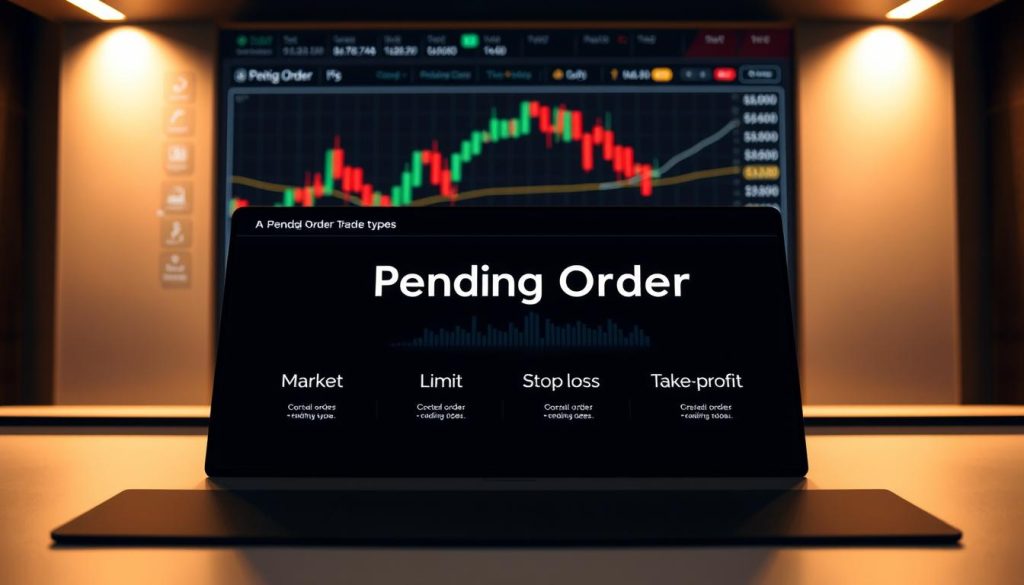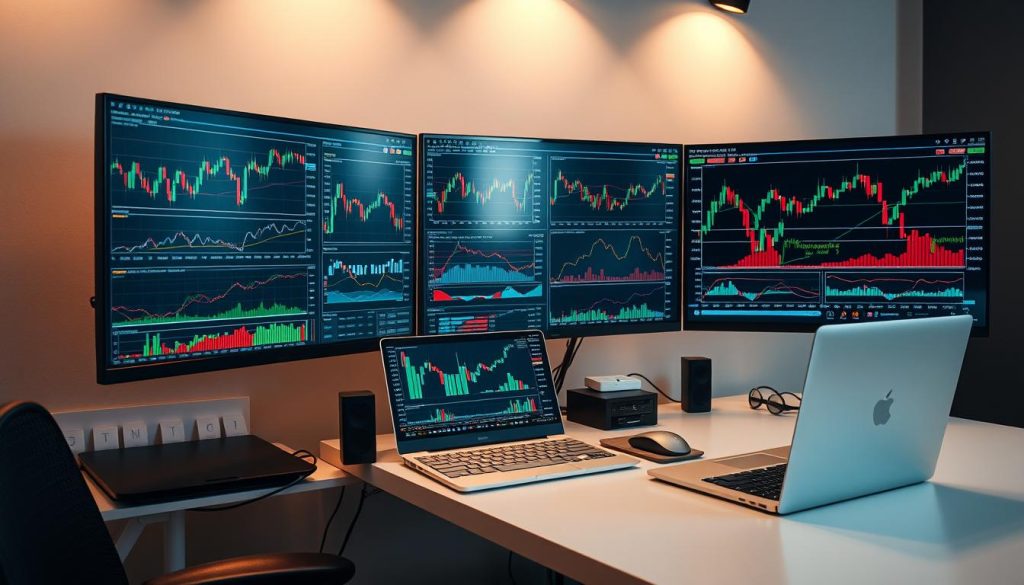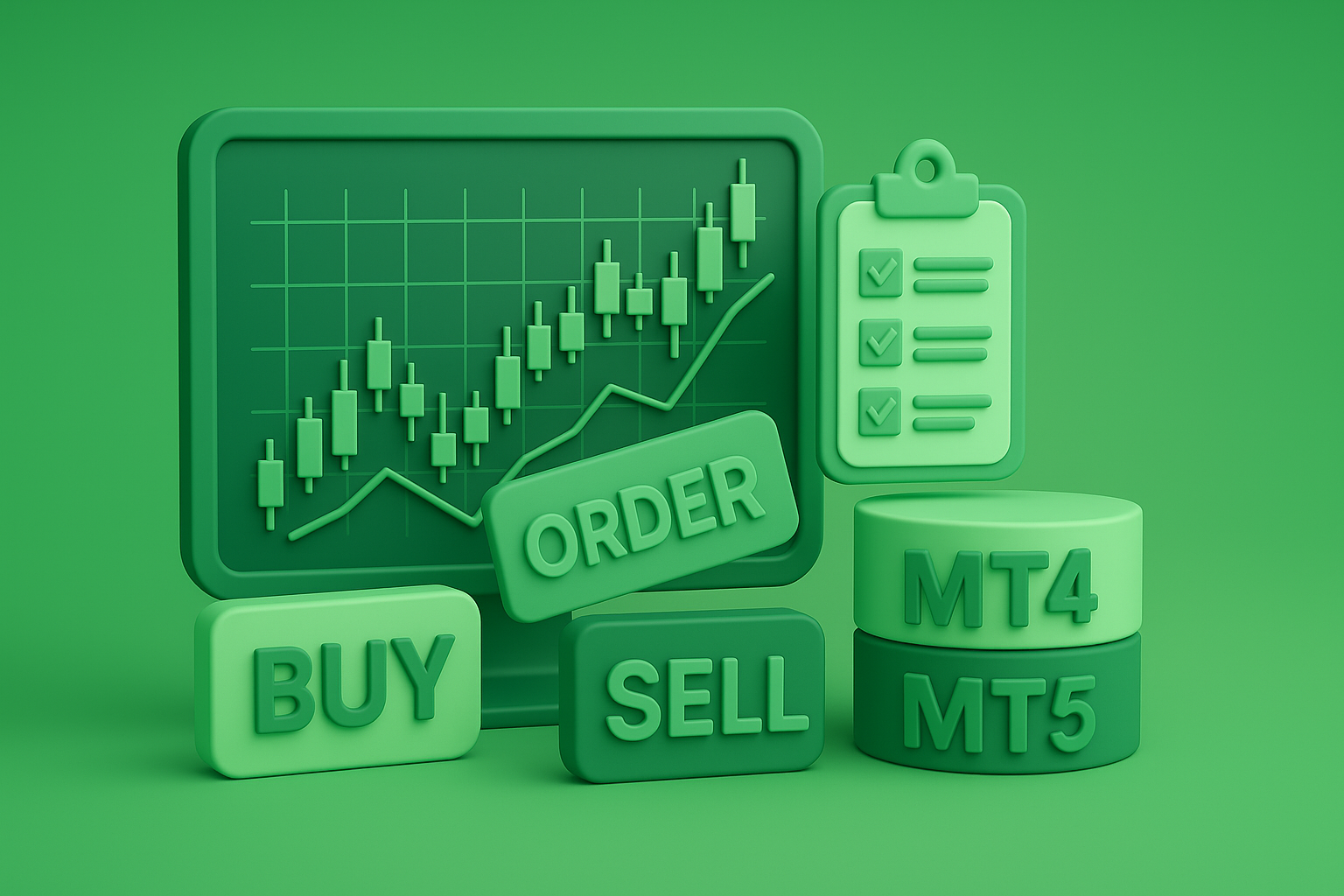Successful market participation requires precision in timing and strategy. Leading financial platforms offer tools to execute trades efficiently, whether managing currencies, commodities, or digital assets. These systems empower users to capitalize on price movements while minimizing exposure to volatility.
The right trading platform provides more than charts and indicators—it delivers robust execution methods tailored to diverse goals. Traders rely on these features to implement stop-loss orders, limit entries, and automate strategies. Understanding these tools separates disciplined professionals from casual participants.
This guide explores execution methods available in popular platforms, comparing their applications across market scenarios. From instant market orders to conditional triggers, each option serves distinct purposes. Proper utilization enhances risk management and helps traders adapt to shifting conditions like news events or liquidity changes.
Key Takeaways
- Advanced execution tools are critical for managing risk in fast-moving markets
- Platform differences impact strategy design across asset classes
- Automated order types help maintain discipline during volatility
- Combining entry and exit methods creates layered protection
- Real-time adaptability separates consistent performers from reactive traders
Understanding MetaTrader Platforms
Navigating financial markets demands more than intuition—it requires robust technological allies. Leading systems combine precision, adaptability, and analytical depth to meet diverse trading needs. These environments transform raw market data into actionable insights through carefully designed interfaces and execution protocols.
Legacy Systems vs Modern Solutions
The fourth-generation system revolutionized currency markets with streamlined workflows and rapid execution. Its successor emerged as a multi-asset solution, bridging gaps between traditional and emerging markets. While the earlier version remains popular for forex specialists, the upgraded model attracts traders seeking diversified portfolios across stocks and commodities.
Core Components for Strategic Execution
Modern platforms provide real-time charting tools with nine timeframes and 80+ technical indicators. Automated strategy deployment through algorithmic scripts enables 24/7 market monitoring. Customizable dashboards allow traders to organize price feeds, economic calendars, and trading terminals within unified workspaces.
Risk management features stand out as critical differentiators. Traders configure stop-loss parameters, margin alerts, and volatility filters directly on price charts. These integrated safeguards help maintain discipline during unexpected market movements while preserving capital for future opportunities.
The Evolution from MT4 to MT5
Financial technology evolves rapidly, and trading systems must adapt to maintain relevance. The transition between platform generations reflects changing market demands and technological capabilities. This progression transformed specialized tools into versatile ecosystems for modern investors.
Historical Development and Upgrades
The fourth iteration launched in 2005 as a forex-focused solution. Five years later, developers unveiled its successor with expanded asset class support. Key improvements included:
- Timeframe options tripling from 9 to 21 intervals
- Technical analysis tools growing by 27%
- Charting objects increasing 42% for detailed market visualization
Differences in Instrument Coverage and Features
While earlier versions specialized in currency pairs, the upgraded platform supports stocks, futures, and commodities. Real-time analysis capabilities improved through additional indicators and customizable dashboards. Multi-asset trading became practical with enhanced execution speeds and risk management tools.
Traders now access deeper market insights through advanced backtesting features. The system’s economic calendar integration helps anticipate volatility, while upgraded scripting languages enable complex automated strategies. These changes reflect user demands for adaptable solutions across global markets.
Key Benefits of Using MetaTrader for Trading
Modern traders require platforms that adapt to their evolving needs while offering robust functionality. Advanced systems bridge the gap between strategy development and real-world execution through versatile features.
Access to Multiple Markets
The best platforms eliminate barriers between asset classes. Users manage currencies, equities, and commodities through single interfaces. This multi-market access lets traders capitalize on opportunities across global exchanges without switching tools.
| System | Use Case | Market Type |
|---|---|---|
| Netting | Consolidating positions | Exchange-traded instruments |
| Hedging | Risk mitigation | Forex & derivatives |
A financial analyst notes:
“Diversification becomes practical when platforms support varied instruments through unified workflows.”
Enhanced Technical Analysis Tools
Sophisticated charting capabilities transform raw data into actionable insights. Traders utilize:
- 38+ built-in indicators for trend identification
- 21 customizable timeframes for precision analysis
- Drag-and-drop tools for pattern recognition
These technical resources empower users to backtest strategies against historical data. Real-time alerts keep traders informed about critical price levels, while customizable templates accelerate decision-making during volatile sessions.
One professional shares:
“Combining multiple analysis methods reduces blind spots in fast-moving markets.”
Exploring Order Types on MetaTrader Platforms
Effective market engagement hinges on understanding the tools that drive trade placement. Modern systems offer distinct pathways for entering positions, each designed for specific market conditions and strategic goals.
Introduction to Order Execution
Two primary methods dominate trade initiation across platforms. Instant execution captures current prices in fast-moving markets, while pending orders act as automated triggers at predetermined levels. These approaches form the foundation for building adaptable strategies.
Traders choose execution styles based on volatility and timing needs. Immediate fills work best during news events or liquid sessions. Delayed entries help capitalize on anticipated breakouts without constant monitoring.
| Order Type | Best Use Case | Key Benefit |
|---|---|---|
| Instant | High-speed entries | Immediate position opening |
| Pending | Strategic positioning | Price-level automation |
A seasoned portfolio manager notes:
“Choosing the right execution method is like having a GPS in volatile markets—it keeps you on track when conditions change.”
Successful practitioners combine both approaches. They might use instant orders for quick adjustments while setting pending triggers for longer-term plays. This dual capability helps balance reactivity with strategic planning.
Deep Dive into Market Orders and Execution
In fast-paced financial environments, split-second decisions determine outcomes. Market orders act as the accelerator pedal for traders needing immediate action, prioritizing speed over price precision.
Immediate Execution and Order Processing
These orders execute at current market prices, ideal for liquid assets like major currency pairs. The system matches buyers and sellers instantly, though final execution prices may differ slightly from initial quotes. This variance—called slippage—occurs most during news releases or thin trading volumes.
| Order Type | Speed | Price Control |
|---|---|---|
| Market | Instant | Low |
| Limit | Delayed | High |
Understanding Price Impact
Large market orders can move prices against traders in less liquid markets. A forex strategist explains:
“Executing 10 lots on a rare currency pair might cost 3 pips more than expected—enough to erase profits.”
Three factors determine price impact:
- Asset liquidity
- Order size relative to market depth
- Current volatility levels
Savvy traders use market orders for breakout strategies or time-sensitive trades, while combining them with stop-loss tools for protection.
Navigating Pending Orders and Their Varieties
Strategic traders deploy automated triggers to capture opportunities without constant monitoring. These preset instructions activate positions when markets reach specified price levels, turning predictions into actionable trades.

Buy Limit and Sell Limit Orders
Buy Limit orders target entries below current prices. Traders use them when expecting rebounds from support zones. For example, purchasing a currency pair at 1.1050 when it’s trading at 1.1100.
Sell Limit instructions work inversely. They activate sales above current values, ideal for profit-taking near resistance areas. This method locks in gains before potential reversals.
| Order Type | Price Relation | Market Outlook |
|---|---|---|
| Buy Limit | Below current | Bullish correction |
| Sell Limit | Above current | Bearish reversal |
Buy Stop and Sell Stop Orders
Buy Stop triggers execute long positions once prices surpass key thresholds. They catch breakout momentum, like entering a rising stock after it clears a 52-week high.
Sell Stop orders activate short positions below current levels. Traders might set these below trendline support when anticipating breakdowns.
A forex strategist notes:
“Pending orders act as tireless sentinels—executing plans precisely while you sleep.”
Combining these tools creates layered strategies. Traders might place Buy Limits near support and Buy Stops above resistance, covering multiple scenarios. This approach balances opportunity capture with disciplined risk management.
Utilizing Stop Loss, Take Profit, and Trailing Stops
Protective mechanisms separate disciplined traders from market casualties. These automated tools enforce strategy adherence while neutralizing emotional responses to price swings. Three critical components form this defense system:
Setting Up Protective Orders
Stop Loss orders act as circuit breakers for open positions. Traders set these below entry points (for long trades) or above them (for shorts). Effective placement considers:
- Volatility measurements using ATR indicators
- Key support/resistance zones on charts
- Account risk tolerance percentages
Take Profit orders secure gains at predefined levels. A forex analyst explains:
“Automated profit-taking prevents greed from overriding your trading plan during parabolic moves.”
| Order Type | Primary Purpose | Ideal Placement |
|---|---|---|
| Stop Loss | Risk containment | Beyond noise zones |
| Take Profit | Reward capture | Near liquidity pools |
Managing Trailing Stop Mechanisms
Trailing stops combine protection with profit optimization. These dynamic tools:
- Adjust stop levels as positions gain value
- Lock in profits during trend extensions
- Maintain risk parameters during reversals
Traders configure trailing increments as fixed pips or percentage-based moves. A 1:3 risk-reward ratio often works well—trailing stops by 3 pips for every 1 pip gained. This approach balances capital preservation with upside potential.
Leveraging Technical Indicators and Charting Tools
Market success hinges on transforming data into actionable insights. Modern platforms equip traders with dynamic charting systems and analytical instruments that decode price movements. These resources turn complex market patterns into clear strategic pathways.

Customizing Charts for Trend Analysis
Traders tailor charts using 21+ timeframes and drawing tools like Fibonacci retracements. Bollinger Bands® help identify volatility thresholds, while moving averages filter market noise. A currency strategist notes:
“Layer three indicators minimum—trend, momentum, and volume—to avoid false signals during choppy sessions.”
| Indicator | Primary Use | Strategy Impact |
|---|---|---|
| RSI | Momentum measurement | Entry timing |
| MACD | Trend confirmation | Position sizing |
| Fibonacci | Support/resistance | Order placement |
Integrating Indicators with Order Management
Analytical tools directly inform trade execution. Traders set buy limits near EMA support zones or trigger stop orders when RSI crosses key levels. This fusion creates:
- Automated entry alerts at predefined conditions
- Dynamic stop-loss adjustments based on volatility
- Profit targets aligned with historical resistance
Advanced systems enable dragging indicator signals onto order tickets. This seamless process reduces execution delays during fast market moves. Traders combine multiple tools to validate signals before committing capital.
Advanced Order
Mastering advanced execution methods elevates trading from reactive decisions to strategic advantage. Sophisticated platforms enable precision through customizable triggers that adapt to evolving market conditions. These tools transform theoretical strategies into actionable plans with mathematical precision.
Traders achieve optimal results by combining automated triggers with real-time technical analysis. Layered stop-loss configurations and dynamic take-profit levels create self-adjusting risk parameters. This fusion allows positions to capitalize on momentum shifts while safeguarding capital during reversals.
Seasoned professionals use conditional orders to execute multi-phase strategies seamlessly. One approach involves pairing entry triggers with trailing stops that lock profits during trends. Such methods reduce emotional interference while maintaining alignment with pre-defined trading plans.
Continuous learning separates exceptional traders from the crowd. Markets reward those who refine execution tactics through backtesting and scenario analysis. Every adjustment to order logic sharpens the competitive edge in fast-moving financial arenas.
FAQ
What are the main differences between MT4 and MT5?
MT4 focuses on forex and CFDs with a simpler interface, while MT5 supports stocks, futures, and commodities. The latter offers more technical indicators, timeframes, and advanced order execution types like netting and hedging.
How do pending orders help in managing trades?
Pending orders let traders set entry points in advance. Buy limits activate below the current price, while buy stops trigger above it. These tools help capitalize on breakouts or reversals without constant market monitoring.
Can trailing stops lock in profits automatically?
Yes. Trailing stops adjust the stop-loss level as the price moves favorably. This protects gains during trends while allowing flexibility if the market reverses, reducing manual adjustments.
What execution options are available for market orders?
Platforms offer instant execution for immediate fills at quoted prices or market execution for slight delays with requotes. Brokers determine which method applies based on liquidity and volatility.
How do technical indicators integrate with trade management?
Tools like moving averages or RSI can generate signals for entry or exit. Traders link these to pending orders or modify stop-loss levels dynamically, aligning strategies with real-time data.
Are commodities and stocks accessible on both platforms?
MT5 provides direct access to exchange-traded stocks and commodities. MT4 primarily supports forex and CFDs, requiring plugins or broker-specific solutions for broader asset coverage.
What advantages do MT5’s charting tools offer?
MT5 includes 21 timeframes, 38 technical indicators, and one-click trading. Charts allow custom templates, graphical objects, and multi-asset analysis, enhancing decision-making for complex strategies.
Can traders copy strategies directly within the platform?
Yes. Both platforms support copy trading through third-party services or broker integrations. Users follow experienced traders, replicating their positions automatically in their accounts.
How does price impact affect order execution?
Large orders in illiquid markets may cause slippage, where fills occur at worse prices. Platforms display depth of market (MT5) or require brokers to optimize execution to minimize such risks.
Why choose MT5 for advanced trading strategies?
MT5’s economic calendar, strategy tester, and algorithmic trading support cater to automated systems. Its expanded instrument range and reduced requotes suit scalpers and high-frequency traders.
Get Started Right: MT5 Simplified with FXNX
To get started in forex, you need a professional yet user-friendly platform. FXNX offers an optimized version of MetaTrader 5 packed with advanced features. Even if you’re new, our tutorials and FXNX demo account will get you started in no time.
FAQ
What are the main differences between MT4 and MT5?
MT4 focuses on forex and CFDs with a simpler interface, while MT5 supports stocks, futures, and commodities. The latter offers more technical indicators, timeframes, and advanced order execution types like netting and hedging.
How do pending orders help in managing trades?
Pending orders let traders set entry points in advance. Buy limits activate below the current price, while buy stops trigger above it. These tools help capitalize on breakouts or reversals without constant market monitoring.
Can trailing stops lock in profits automatically?
Yes. Trailing stops adjust the stop-loss level as the price moves favorably. This protects gains during trends while allowing flexibility if the market reverses, reducing manual adjustments.
What execution options are available for market orders?
Platforms offer instant execution for immediate fills at quoted prices or market execution for slight delays with requotes. Brokers determine which method applies based on liquidity and volatility.
How do technical indicators integrate with trade management?
Tools like moving averages or RSI can generate signals for entry or exit. Traders link these to pending orders or modify stop-loss levels dynamically, aligning strategies with real-time data.
Are commodities and stocks accessible on both platforms?
MT5 provides direct access to exchange-traded stocks and commodities. MT4 primarily supports forex and CFDs, requiring plugins or broker-specific solutions for broader asset coverage.
What advantages do MT5’s charting tools offer?
MT5 includes 21 timeframes, 38 technical indicators, and one-click trading. Charts allow custom templates, graphical objects, and multi-asset analysis, enhancing decision-making for complex strategies.
Can traders copy strategies directly within the platform?
Yes. Both platforms support copy trading through third-party services or broker integrations. Users follow experienced traders, replicating their positions automatically in their accounts.
How does price impact affect order execution?
Large orders in illiquid markets may cause slippage, where fills occur at worse prices. Platforms display depth of market (MT5) or require brokers to optimize execution to minimize such risks.
Why choose MT5 for advanced trading strategies?
MT5’s economic calendar, strategy tester, and algorithmic trading support cater to automated systems. Its expanded instrument range and reduced requotes suit scalpers and high-frequency traders.
